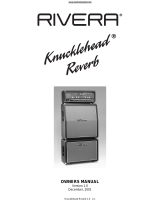Mesa/Boogie D-180 User manual
- Category
- Supplementary music equipment
- Type
- User manual
This manual is also suitable for
Mesa/Boogie D-180: A versatile two-channel guitar and bass preamplifier with a unique Master control that functions as a variable current limiter, allowing for infinite sustain and full crank sound at any volume. The D-180 also features a sophisticated Effects Loop with a Blend control for mixing dry and effected signals, and a variety of rear-panel features including speaker jacks, Slave Level control, Slave Output, and 600 ohm Balanced Output.
Mesa/Boogie D-180: A versatile two-channel guitar and bass preamplifier with a unique Master control that functions as a variable current limiter, allowing for infinite sustain and full crank sound at any volume. The D-180 also features a sophisticated Effects Loop with a Blend control for mixing dry and effected signals, and a variety of rear-panel features including speaker jacks, Slave Level control, Slave Output, and 600 ohm Balanced Output.




-
 1
1
-
 2
2
-
 3
3
-
 4
4
Mesa/Boogie D-180 User manual
- Category
- Supplementary music equipment
- Type
- User manual
- This manual is also suitable for
Mesa/Boogie D-180: A versatile two-channel guitar and bass preamplifier with a unique Master control that functions as a variable current limiter, allowing for infinite sustain and full crank sound at any volume. The D-180 also features a sophisticated Effects Loop with a Blend control for mixing dry and effected signals, and a variety of rear-panel features including speaker jacks, Slave Level control, Slave Output, and 600 ohm Balanced Output.
Ask a question and I''ll find the answer in the document
Finding information in a document is now easier with AI
Related papers
-
Mesa/Boogie Mark IV User manual
-
Mesa/Boogie Three Channel Dual & Triple Rectifier Solo Heads User manual
-
Mesa/Boogie Three Channel Dual & Triple Rectifier Solo Heads Owner's manual
-
Mesa Boogie Mark Five User manual
-
Mesa/Boogie Stereo Amplifier TITAN V-12 User manual
-
Mesa/Boogie 55 User manual
-
Mesa/Boogie Solo 50 RectoVerb Version 2 User manual
-
Mesa/Boogie LoneStar Amplifier User manual
-
Mesa/Boogie Three Channel Dual & Triple Rectifier Solo Heads User manual
-
Mesa/Boogie OOGIEBMESA User manual
Other documents
-
 Rivera Knucklehead Reverb KR 100 T Owner's manual
Rivera Knucklehead Reverb KR 100 T Owner's manual
-
Fender Dual Showman Owner's manual
-
TRAYNOR YCS90 Owner's manual
-
 YORKVILLE TRAYNOR YCS50 Owner's manual
YORKVILLE TRAYNOR YCS50 Owner's manual
-
Lexicon Signature 284 User manual
-
SWR Musical Instrument Amplifier 750x User manual
-
Genz Benz GBE 750 Technical Manual
-
Fender Twin Amp ('94 Twin, Evil Twin) User manual
-
Fender Power Chorus Owner's manual
-
Fender Princeton Chorus DSP Owner's manual





